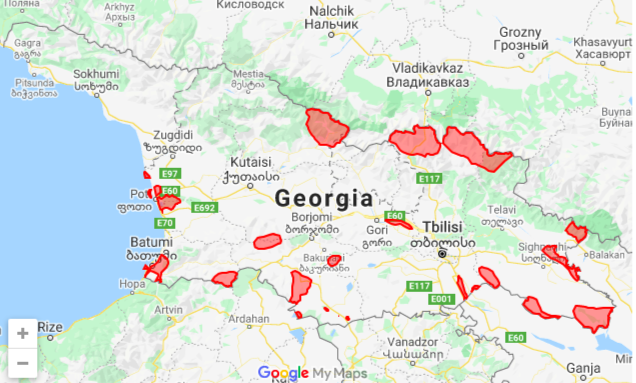Taxonomy
Kingdom Animalia (16266)Phylum Chordata (708)
Class Actinopterygii (120)
Order Acipenseriformes (6)
Family Acipenseridae (6)
Genus Acipenser (5)
Species Acipenser sturio
Browse by taxonomy
Simple search by name
Acipenser sturio ✓
European sturgeon;Atlantic sturgeon, ფორონჯი,ფორეჯი
Name According To: https://www.iucnredlist.org; http://www.marinespecies.org;https://www.gbif.org;https://www.fishbase.de
Species: sturio
Taxon Rank: Species
Scientific Name Authorship: Linnaeus, 1758
Vernacular Name: European sturgeon;Atlantic sturgeon
Georgian Name: ფორონჯი,ფორეჯი
GBD Remarks:
Conservation Status (International): Critically Endangered A2cde; B2ab(ii,iii,v) ver 3.1 Once a broad range is strongly reduced. The latest recorded spawning in 1994, Garonne, France. Current population size in France is between 20-750 of mature individuals. More than a 90% population declined in the past 75 years based mainly on loss of habitat, along with pollution and overfishing.
Conservation Status (national): Georgian Red List (2006): Critically Endangered, national conservation status repeats worldwide status, according to IUCN. Included in the list of key animal species, National Biodiversity Strategy and Action Plan for Georgia (2005) – as an endangered fish species
Threats are: overfishing, seizing the largest and mature fish due to poaching and due to bycatch of marine fishing, preventing natural reproduction by dam-building, water abstraction and drought of spawning habitats.
Economic importance (national): Currently low, because of very low density. Potentially interesting species for re-stocking in Rioni. Potentially, economically highly important species.
Methodological approaches: non-extractive counts at spawning sites.
Research activities: Dr. Biol.Sc. Nargiza Ninua, Archil Guchmanidze in Batumi were conducting occasional research during the recent years.
Relevant website: http://www.iucnredlist.org/details/230/0 ; http://www.iucnredlist.org/details/232/0 ; http://www.iucnredlist.org/details/235/0 ; http://www.iucnredlist.org/details/225/0 ; http://www.iucnredlist.org/details/229/0 ; http://www.iucnredlist.org/details/10269/0;
http://nacres.org/pdf/bsap_en.pdf
Why to monitor: Rare and important for conservation. Flagship species for Georgia and Caucasus (WWF Action Plan for Caucasus). However, no self-sustainable population does present in Georgia. Systematic annual monitoring of these species would include much and expensive effort for the analysis of the national population, with a high risk not to reveal a single reproductive individual.
Preliminary suggestion: rely on the records of the sturgeons harvest (by-catch and poaching data) and develop non-extractive and non-invasive methods of the monitoring on spawning grounds in rivers.
კონსერვაციული სტატუსი (საერთაშორისო) Critically Endangered A2cde; B2ab(ii,iii,v) ver 3.1. თავის დროზე დიდი არეალი უკიდურესად შემცირებულია. ბუნებაში ქვირითობის ბოლო შემთხვევაა დაფიქსირებული 1994 წელს გარონაში, საფრანგეთი. ფრანგული პოპულაცია დღეს ითვლის 20-750 ზრდასრულ ინდივიდს. პოპულაცია 90%-ზე მეტით შემცირდა ბოლო 75 წლის განმავლობაში, ძირითადად საქვირითეების პირობების გაუარესების გამო, დაბინძურებასთან და ჭარბ თევზჭერასთან ერთად.
კონსერვაციული სტატუსი (ეროვნული): საქართველოს წითელი ნუსხა (2006): CE, ეროვნული სტატუსი საერთაშორისო სტატუსს იმეორებს. საფრთხეებია: ზღვაში თევზჭერა, განსაკუთრებით დიდი მექვირიტე ინდივიდების ამოღება პოპულაციიდან, დამბების აშენება (რაც ხელს უშლის მდინარეების გამოყენებას საქვირითედ), წყლის დონის დაცემა ბუნებრივ საქვირითეებში. რამდენადაც ზუთხების სიცოცხლის ხანგრძლივობა მაღალია, ზოგ ადგილადს დღესაც მოიპოვება ზრდასრული ინდივიდები, რაც არ ნიშნავს მათ წარმატებულ რეპროდუქციას. შეტანილია მნიშვნელობანი სახეობების ნუსხაში, საქართველოს ბიომრავალფეროვნების სტრატეგია და მოქმედებათა გეგმა (2005) - როგორც მოწყვლადი თევზის სასხეობა.
ეკონომიკური მნიშვნელობა (ეროვნული): ამჟამად დაბალი, მცირე რიცხოვნობის გამო. პოტენციალურად ძალიან მნიშვნელოვანი სარეწაო თევზია. პოტენციალურად შესაძლებელია რიონის პოპულაციის აღდგენა.
მონიტორინგის მეთოდები: თვლა ქვირითობის ადგილებში (ამოღების გარეშე)
კვლევითი აქტივობა: ნარგიზა ნინუა (საქართველოს ეროვნული მუზეუმი). არჩილ გუჩმანიძე (ბათუმი). სპეციფიკური პროექტი არ მიმდინარეობს, თუმცა წინა წლებში გარკვეული ინფორმაცია არის დაგროვილი.
სასარგებლო ბმულები: http://www.iucnredlist.org/details/230/0 ; http://www.iucnredlist.org/details/232/0 ; http://www.iucnredlist.org/details/235/0 ; http://www.iucnredlist.org/details/225/0 ; http://www.iucnredlist.org/details/229/0 ; http://www.iucnredlist.org/details/10269/0;
http://nacres.org/pdf/bsap_en.pdf
მონიტორინგის საჭიროება: იშვიათია და მისი კონსერვაცია ძალზე მნიშვნელოვანია. შეტანილია WWF - ის კავკასიის ბიომრავალფეროვნების სამოქმედო გეგმაში. თუმცა, როგორც ჩანს, საქართველოში მდგრადი პოპულაცია აღარ არსებობს.
რეკომენდაცია. მონაცემები სახეობის ჭერის და შეხვედრის შესახებ შეჯამდეს და შეინახოს ერთიან მონაცემთა ბაზაში. დამუშავდეს ქვირითის მონიტორინგის არაინვაზიური მეთოდები.
Page Authors: Kandaurov A. ,
Reference of occurrence in Georgia: Elanidze, R. F., 1983. Ichtiological fauna of Georgian Rivers and Lakes. Tbilisi, Metsniereba (in Russian)
Information from GBIF about Acipenser sturio
GBIF scientific name: Acipenser sturio Linnaeus, 1758
GBIF taxonomic status: ACCEPTED

Conservation Status
This section is under construction
National Red List Status: DD
IUCN Red List Status: CR
Protection status: Not defined
Reason: N/A
Trend: Unknown
Native/Introduced: Native
Comment: Critically Endangered worldwide A1acde+2d; 3.1: IUCN, 2001; presence in Georgia not confirmed, probably regionally extinct
Georgian Name: ფორონჯი,ფორეჯი
English Name: European sturgeon;Atlantic sturgeon
Synonyms: Accipenser attilus;Acipenser ducissae;Acipenser europaeus;Acipenser hospitus ;Acipenser laevissimus;Acipenser milberti ;Acipenser sturioides
Taxonomy according to: https://www.iucnredlist.org; http://www.marinespecies.org;https://www.gbif.org;https://www.fishbase.de
References: Current and Historical Status of Sturgeon (Acipenseridae, Osteichthyes) in Georgia;A.Guchmanidze;STATUS AND PROTECTION OF GLOBALLY THREATENED SPECIES IN THE CAUCASUS;Tbilisi, Georgia,December 2009pp. 171-177;დისერტაცია ა.გუჩმანიძე:'საქართველოს შავი ზღვის
Evaluated By: Mikeladze R, Mgeladze M, Goradze R, Japoshvili B, Epitashvili G, Kuljanishvili T.
Date evaluated: Nov 2021

